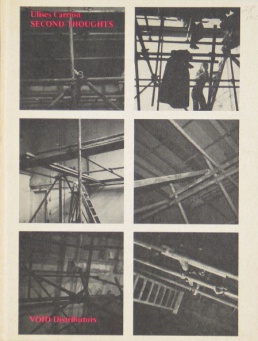Difference between revisions of "Ulises Carrión"
| Line 4: | Line 4: | ||
He studied philosophy and literature in Mexico City, Paris and Leeds, and lived in Amsterdam from 1970 until the end of his life. His art has been exhibited in various locations in The Netherlands, Mexico and elsewhere. Carriónwas the author of several books and in 1975 founded Other Books and So, a distribution centre for artists' publications and multiples. Carrion arrived at visual art practice through his interest in print culture and media, which led him to engage with mail art and eventually performance, film and video. He was closely involved with the In-Out Center, an alternative Amsterdam gallery which drew artists of diverse cultural backgrounds, whose work in some way commented on Dutch art and society from their own cultural perspective. The continuation of his engagement with literary formats can be seen in the videos' examinations of the strategies and devices used to create narrative structure in a film, story or artwork. [http://www.li-ma.nl/site/catalogue/agent/ulises-carrion/19 (Source)] | He studied philosophy and literature in Mexico City, Paris and Leeds, and lived in Amsterdam from 1970 until the end of his life. His art has been exhibited in various locations in The Netherlands, Mexico and elsewhere. Carriónwas the author of several books and in 1975 founded Other Books and So, a distribution centre for artists' publications and multiples. Carrion arrived at visual art practice through his interest in print culture and media, which led him to engage with mail art and eventually performance, film and video. He was closely involved with the In-Out Center, an alternative Amsterdam gallery which drew artists of diverse cultural backgrounds, whose work in some way commented on Dutch art and society from their own cultural perspective. The continuation of his engagement with literary formats can be seen in the videos' examinations of the strategies and devices used to create narrative structure in a film, story or artwork. [http://www.li-ma.nl/site/catalogue/agent/ulises-carrion/19 (Source)] | ||
| − | + | ==Works== | |
* [http://ubu.com/sound/carrion.html Carrión's sound poetry on UbuWeb] | * [http://ubu.com/sound/carrion.html Carrión's sound poetry on UbuWeb] | ||
* [http://www.li-ma.nl/site/catalogue/agent/ulises-carrion/19 Excerpts from Carrión's video works at LIMA archive] | * [http://www.li-ma.nl/site/catalogue/agent/ulises-carrion/19 Excerpts from Carrión's video works at LIMA archive] | ||
* ''[http://monoskop.org/log/?p=14521 Second Thoughts]'', Amsterdam: VOID, 1980, 72 pp. Collection of 8 essays. {{en}} | * ''[http://monoskop.org/log/?p=14521 Second Thoughts]'', Amsterdam: VOID, 1980, 72 pp. Collection of 8 essays. {{en}} | ||
| − | + | ==Literature== | |
* Donna Conwell, [http://www.e-flux.com/projects/do_it/notes/essay/e003_text.html "Personal Worlds or Cultural Strategies?"], 2002. {{en}} | * Donna Conwell, [http://www.e-flux.com/projects/do_it/notes/essay/e003_text.html "Personal Worlds or Cultural Strategies?"], 2002. {{en}} | ||
* Desde Uruguay, Clemente Padín, [http://www.escaner.cl/escaner87/acorreo.html "Recordando a Ulises Carrión"], ''Escáner'' 87 (Sep 2006). {{es}} | * Desde Uruguay, Clemente Padín, [http://www.escaner.cl/escaner87/acorreo.html "Recordando a Ulises Carrión"], ''Escáner'' 87 (Sep 2006). {{es}} | ||
| Line 15: | Line 15: | ||
* Mónica de la Torre, [http://bombmagazine.org/article/6931/ulises-carri-n-s-the-poet-s-tongue "Ulises Carrión's The Poet's Tongue"], ''BOMB'' 122 (Winter 2013). {{en}} | * Mónica de la Torre, [http://bombmagazine.org/article/6931/ulises-carri-n-s-the-poet-s-tongue "Ulises Carrión's The Poet's Tongue"], ''BOMB'' 122 (Winter 2013). {{en}} | ||
| − | + | ==Links== | |
* [http://www.archivolafuente.com/en/fondos-y-conjuntos/fondo-ulises-carrion Ulises Carrión Fonds at Archivo Lafuente] | * [http://www.archivolafuente.com/en/fondos-y-conjuntos/fondo-ulises-carrion Ulises Carrión Fonds at Archivo Lafuente] | ||
* [http://mailartists.wordpress.com/2011/01/30/ulises-carrion/ Carrión at Mail Artists Index] | * [http://mailartists.wordpress.com/2011/01/30/ulises-carrion/ Carrión at Mail Artists Index] | ||
| Line 21: | Line 21: | ||
* [http://www.museoreinasofia.es/en/exhibitions/ulises-carrion Exhibition at Reina Sofia, Madrid], 2016. [http://www.museoreinasofia.es/en/activities/new-art-making-books Seminar]. | * [http://www.museoreinasofia.es/en/exhibitions/ulises-carrion Exhibition at Reina Sofia, Madrid], 2016. [http://www.museoreinasofia.es/en/activities/new-art-making-books Seminar]. | ||
* [http://de.wikipedia.org/wiki/Ulises_Carri%C3%B3n Carrión at German Wikipedia] | * [http://de.wikipedia.org/wiki/Ulises_Carri%C3%B3n Carrión at German Wikipedia] | ||
| + | * https://www.facebook.com/UlisesCarrion/ | ||
[[Category:Artists' books]] [[Category:Mail art]] [[Category:Conceptual art]] {{DEFAULTSORT:Carrion, Ulises}} | [[Category:Artists' books]] [[Category:Mail art]] [[Category:Conceptual art]] {{DEFAULTSORT:Carrion, Ulises}} | ||
Revision as of 13:03, 24 September 2016
A key figure in Mexican conceptual art, Ulises Carrión (1941, San Andrés Tuxtla, Mexico – 1989, Amsterdam) was an artist, editor, curator, and theorist of the post-1960s international artistic avant-garde.
He studied philosophy and literature in Mexico City, Paris and Leeds, and lived in Amsterdam from 1970 until the end of his life. His art has been exhibited in various locations in The Netherlands, Mexico and elsewhere. Carriónwas the author of several books and in 1975 founded Other Books and So, a distribution centre for artists' publications and multiples. Carrion arrived at visual art practice through his interest in print culture and media, which led him to engage with mail art and eventually performance, film and video. He was closely involved with the In-Out Center, an alternative Amsterdam gallery which drew artists of diverse cultural backgrounds, whose work in some way commented on Dutch art and society from their own cultural perspective. The continuation of his engagement with literary formats can be seen in the videos' examinations of the strategies and devices used to create narrative structure in a film, story or artwork. (Source)
Works
- Carrión's sound poetry on UbuWeb
- Excerpts from Carrión's video works at LIMA archive
- Second Thoughts, Amsterdam: VOID, 1980, 72 pp. Collection of 8 essays. (English)
Literature
- Donna Conwell, "Personal Worlds or Cultural Strategies?", 2002. (English)
- Desde Uruguay, Clemente Padín, "Recordando a Ulises Carrión", Escáner 87 (Sep 2006). (Spanish)
- Gerrit Jan de Rook, "Ulises Carrión and Other Books and So", trans. Mari Shields, Metropolis M 5 (Oct-Nov 2010). (English)
- Mónica de la Torre, "Ulises Carrión's The Poet's Tongue", BOMB 122 (Winter 2013). (English)
